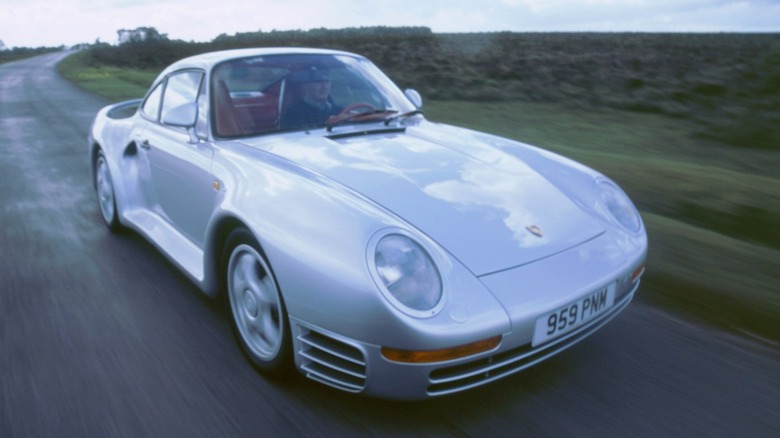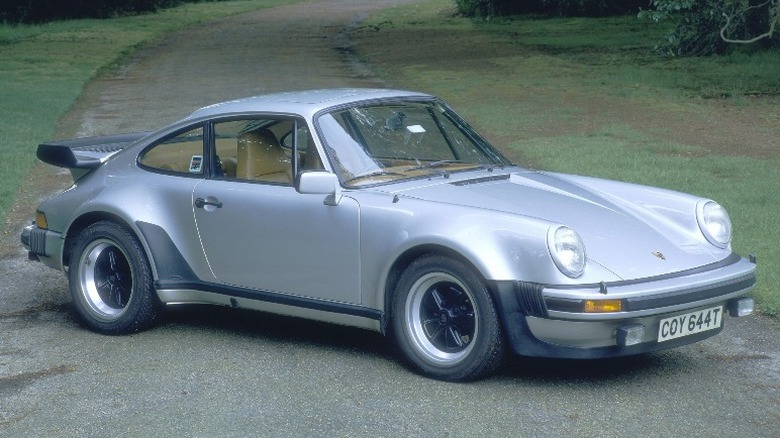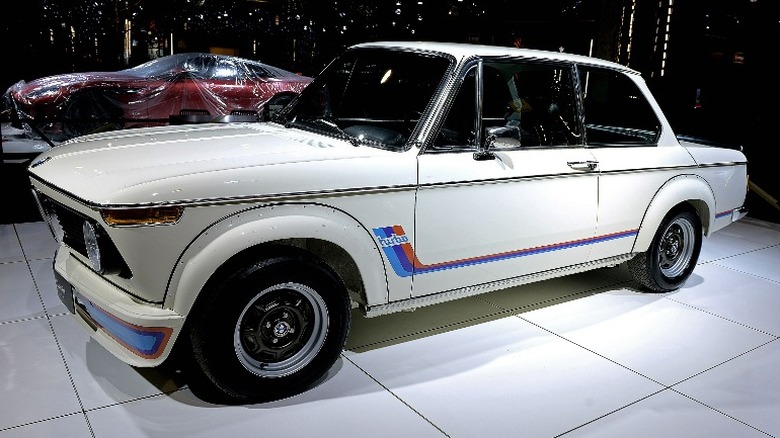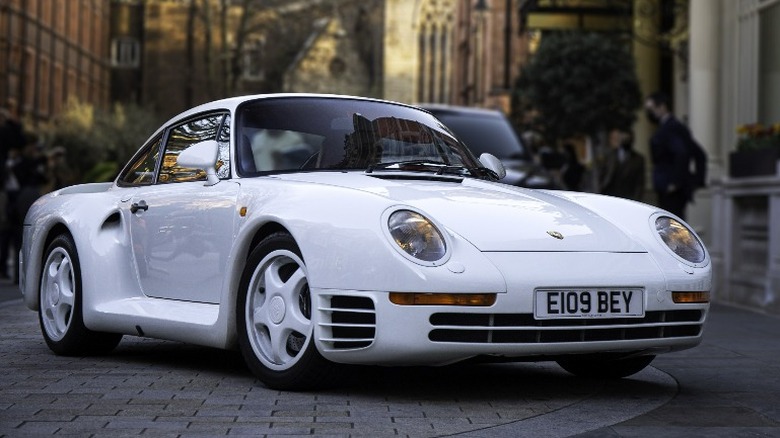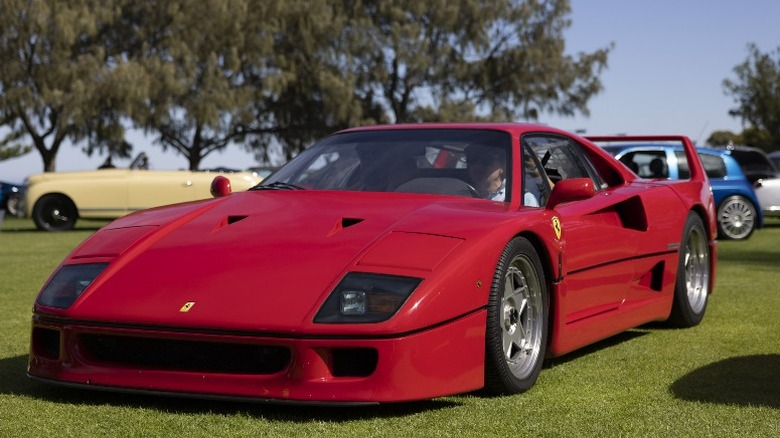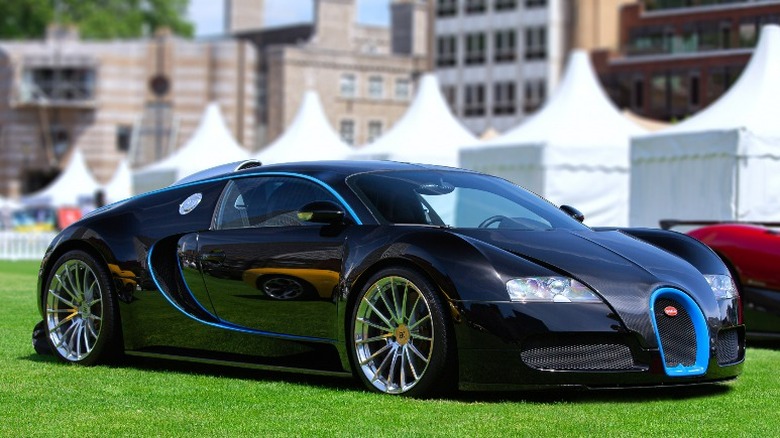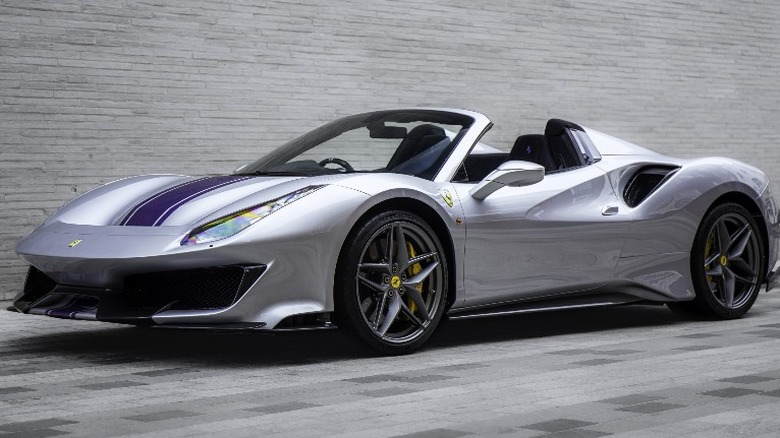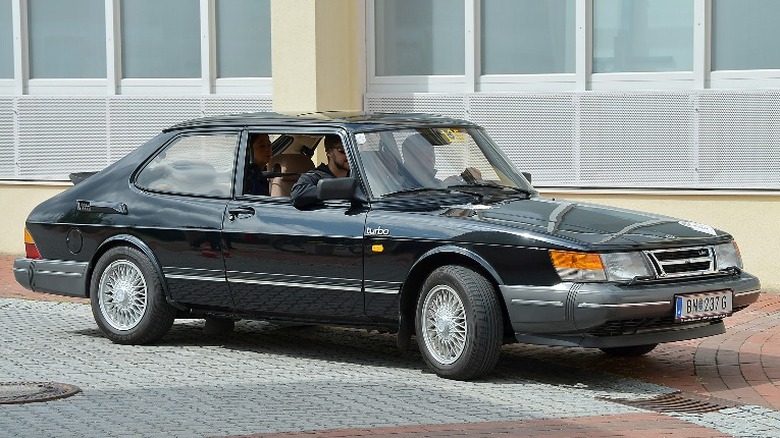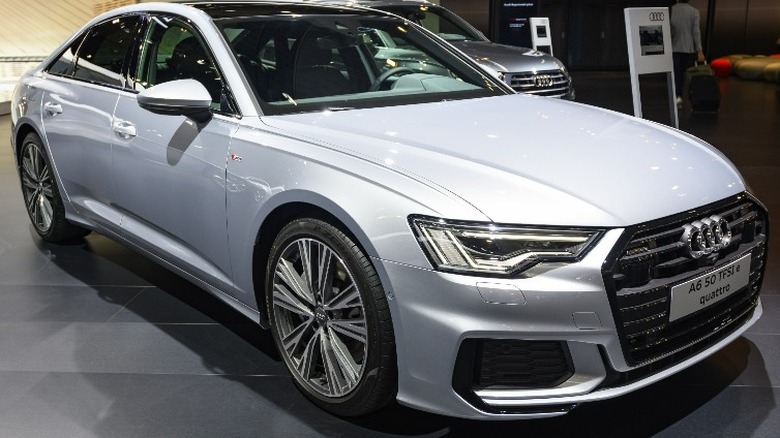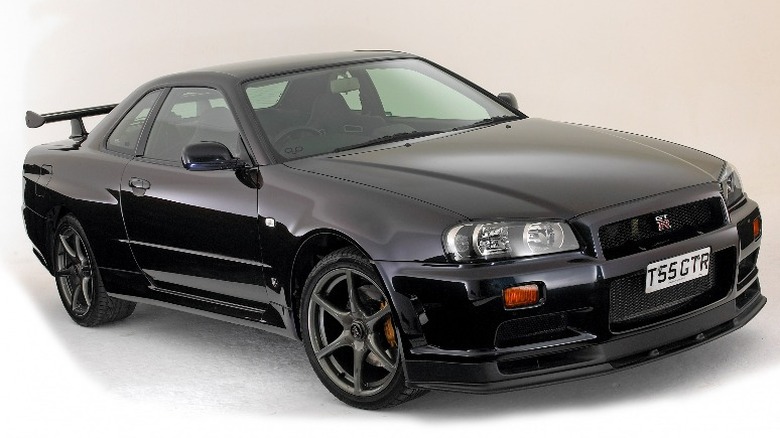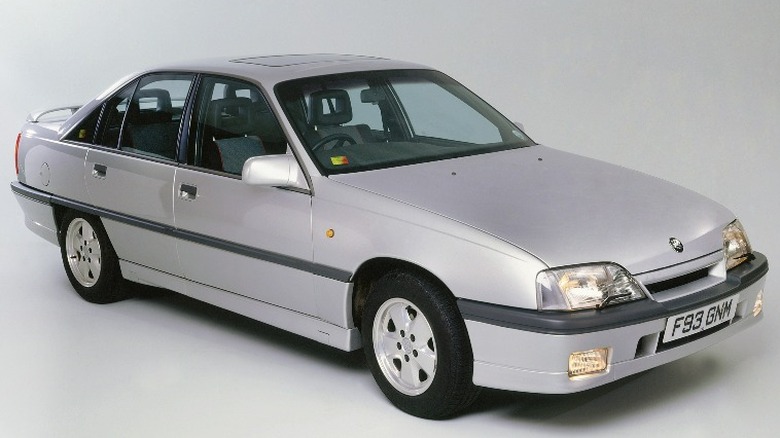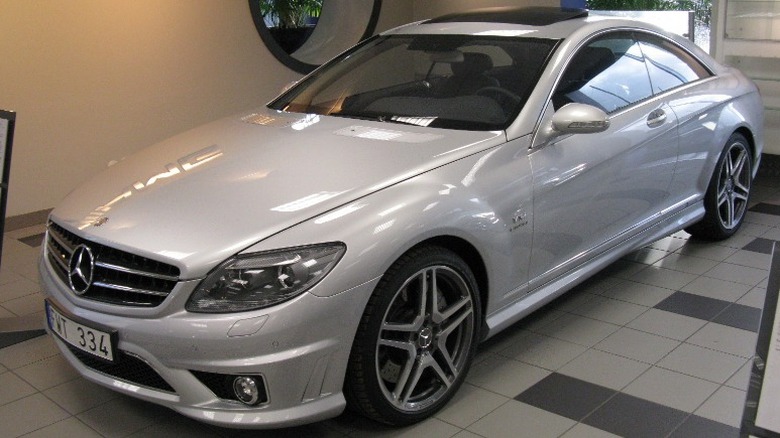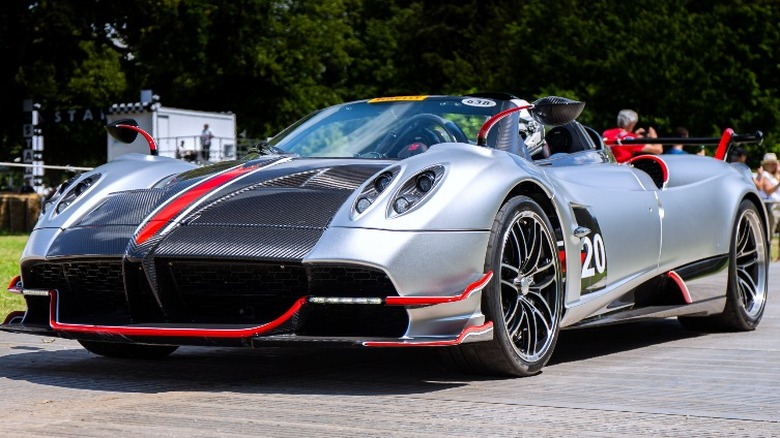The 12 Best Turbo Cars Ever Made, Ranked
Turbocharging technology has been around for over 100 years. Industrial use of the turbocharger began in 1925 when the device was successfully installed in a 10-cylinder diesel engine used on two German passenger ships to increase the output from 1,750 to 2,500 horsepower (via MotorTrend). During World War II, turbochargers were implemented on several aircraft engines, but they didn't appear in the automobile industry until 1962 when General Motors introduced the Chevrolet Corvair Monza and the Oldsmobile Jetfire (via The New York Times). According to Hemmings, with its turbocharged engine, the Monza gained a reputation as an affordable performance car, generating 150 horsepower. However, perhaps the most significant impact on the development of turbocharging in road car performance occurred with the introduction of the Porsche 930 (911 Turbo) in 1975. The term "turbo" alone conjures up images of a high-performance sports car with flared fenders, whale-tail spoilers, and blistering acceleration.
Power output is not the only reason for building turbocharged engines. The technology has surged in production automobiles in recent years as manufacturers strive to meet increasingly stringent fuel economy standards. The boost in horsepower allows automakers to install smaller engines in cars without sacrificing the power that consumers expect in modern vehicles. These smaller engines use less fuel in stop-and-go traffic when idling or coasting, but offer extra power with the turbocharger when needed.
While fuel efficiency may be the driving factor for turbocharging many of today's cars, performance is still the most significant criterion for selecting the best turbo cars ever made.
Porsche 911 Turbo
Porsche began developing turbocharging technology for its race cars in the 1960s, and the success it had with the turbocharged 917/30 inspired the sports car company to enhance the 911 road car with the same technology. The Turbo Carrera (internally referred to as the 930 and the 911 Turbo to the public) became the top model during its production run from 1975 to 1989. At the time of its introduction, the 911 Turbo was the fastest German production car, providing competition for the more exclusive and expensive vehicles from Ferrari and Lamborghini.
Porsche adapted the 917/30 CAN-AM car turbo to the Carrera RS 3.0-liter flat-six and installed the Bosch K-Jetronic electronic fuel injection, creating a powerplant capable of producing 260 horsepower and reaching a top speed of 155 mph. To ensure the 911 platform had sufficient strength to handle the higher power output, Porsche upgraded the suspension, installed larger brakes, and equipped it with a more robust four-speed gearbox (via Carfolio).
The menacing "whale-tail" spoiler channeled additional air to the rear-mounted engine and produced significant downforce on the back end of the vehicle. The flared fenders added to the intimidating appearance and, along with wider rear wheels and high-performance tires, increased the 911's width and grip, making it more stable. The Porsche 911 Turbo represents the first road car with an unparalleled powerful turbocharged engine that was a threat on the racetrack, but civil enough for daily driving.
BMW 2002 Turbo
Although turbo production cars had been available in the U.S. since 1962, the first European turbocharged model didn't arrive until BMW introduced the 2002 Turbo in 1973. The high-performance 2002 was distinguished from previous models with exterior paintwork featuring racing-style stripes on both sides of the car, a restyled, more aggressive spoiler, wider wheels, and no front bumper.
To power the new model, the German car manufacturer chose the well-tested and reliable 2-liter, four-cylinder engine used in the 2002 ti (1968 to 1972) and the 2002 tii (1971 to 1975). The powerplant performed well in both cars, developing 120 horsepower at 5,500 revolutions per minute in the 2002 ti, and 130 horsepower at 5,800 revolutions per minute in the 2002 tii. However, the 2002 Turbo with a 2.0-liter Kuhnle, Kopp, and Kausch turbocharged engine showed a significant improvement in performance, delivering an impressive 170 horsepower at 5,800 revolutions per minute, and a maximum torque of 173 pound-feet at 4,000 revolutions per minute.
The sedan accelerated to 60 mph in just 7.0 seconds and reached a top speed of 130 mph. To provide adequate stopping power, BMW upgraded to ventilated disc brakes on the front and larger drum brakes on the rear.
According to Autoevolution, only 1,672 units were made before the BMW 2002 Turbo was discontinued in 1974. Although the 2002 Turbo was short-lived, the turbocharged sedan set the standard for many European cars to follow, built with small, fuel-efficient engines producing respectable output and offering good performance.
Porsche 959
Although the Porsche 930 was a pioneer in the use of turbocharging for high-performance sports cars, the technologically-advanced Porsche 959, banned for import to the U.S., was a model for future supercars in Europe.
Porsche started with the 911, using it as a base to create the 959, although the finished product shares very little with its donor. The 959 made use of a new Porsche-Steuer Kupplung (PSK) electronic all-wheel-drive system, still considered today to be one of the most advanced ever made (via Autoevolution). The German automaker kept the weight to a minimum by making the body with a Kevlar composite, the doors and hood with aluminum, and the wheels with a lightweight magnesium alloy.
In addition, the 959 was the first road car equipped with tire pressure sensors and an active differential. It was also the first mass-produced car to offer a six-speed manual transmission. The 2.9-liter, twin-turbo flat-six used a hybrid air- and water-cooled design to produce 444 horsepower and 369 pound-feet of torque. Porsche made the block, heads, and pistons from aluminum, installed titanium connecting rods, and a dry-sump oiling system to create a lightweight and compact engine.
The 959 accelerated from 0 to 60 mph in a mere 3.7 seconds and reached a top speed of 197 mph (via TopSpeed). Even today, few supercars can exceed the acceleration, speed, and raw performance of the remarkable Porsche 959.
Ferrari F40
The Ferrari F40 was the first production car to reach a top speed of 200 mph, and it achieved the milestone without the traditional V12 powerplant typical of Ferrari race cars. A twin-turbocharged 2.9-liter V8 cranked out an impressive 478 horsepower at 7,000 revolutions per minute, albeit with the significant "lag" characteristic of earlier turbochargers.
The F40 was the last car developed and built under Enzo Ferrari's direct supervision before his death. He directed his design team to create a road car that would glean technology from Ferrari's successful turbocharged Formula One race cars. Based on the 288 GTO, Ferrari built the F40 as a stripped-out racing car for the road that included only essential systems.
Scaglietti fabricated the body with advanced composite materials including cutting-edge Kevlar, carbon fiber, and aluminum all integrated into a steel chassis. Pininfarina designed the body shape with features to reduce frontal area, lift and achieve a low drag coefficient of 0.34, and featured a Lexan hood that revealed the twin-turbo V8 engine (via Supercars.net).
The powerful turbocharged powerplant combined with lightweight racecar features gave the Ferrari F40 the performance it needed to place it among the best Ferrari cars ever made and replace the Porsche 959 as the fastest car on the road.
According to Ferrari, the F40 accelerated to 62 mph in a mere 4.1 seconds on its way to its record-setting top speed.
Bugatti Veyron
The Bugatti Veyron represents turbocharging technology in its most extreme form. Equipped with a quad-turbocharged 8-liter W-16 with aluminum block and heads and port fuel injection, the hypercar produces 1,001 horsepower at 6,000 revolutions per minute and a maximum torque of 922 pound-feet at 2,200 revolutions per minute. It is one of the quickest cars of all time, the first to accelerate to 60 mph in mere 2.5 seconds, and it is capable of exceeding 250 mph at the top end (via Car and Driver).
The Bugatti Veyron looks like a car from a futuristic movie, costs nearly $2 million, and boasts every state-of-the-art technology feature available. However, the exceptional performance sets the car apart from other hypercars in its class.
John Phillips of Car and Driver best described the exhilarating sensation of the Veyron's acceleration: "From rest, the car leaves civilly, gentlemanly, with almost no wheelspin or tire squeal. It accelerates briskly for roughly one second until the turbos understand that you mean business. Then there is a deafening roar, the nose lifts, and the car feels as if it's making a serious attempt to claw itself into the air."
As impressive as the Veyron is, its sibling the Chiron, equipped with an 8.0-liter, 16-cylinder engine using four turbochargers making 1,500 horsepower, accelerates to 60 mph in 0.2 seconds less, and reaches a top speed of 261 mph.
Ferrari 488 Pista
Well known for its naturally-aspirated V12 powerplants, Ferrari also produces some impressive V8 engines with turbochargers. The Ferrari 488 Pista (pista means track in Italian), first introduced in 2018, is equipped with the company's most powerful V8 engine. The twin-turbocharged 3.9-liter V8 produces 711 horsepower at 8,000 revolutions per minute, and a torque peaking at 567 pound-feet (via Car and Driver). Top Gear Magazine awarded the 488 Pista its 2018 "Supercar of the Year." To receive such a distinction, a supercar must meet several requirements: The car must be light, powerful, and walk a fine line between pushing the boundaries of tech while also remaining aesthetically exhilarating. But most of all, the best supercar of the year must be fast.
Ferrari offers the 488 Pista in a coupe or convertible (the Spider). The coupe weighs 1,280 kilograms dry (90 kilograms less than a regular 488 GTB), while the Spider weighs around 50 kilograms more. In Car and Driver track tests, the coupe accelerated from 0 to 60 mph in a blistering 2.7 seconds, making it competitive with the McLaren 720S, and only slightly slower than the Lamborghini Huracán Evo at 2.5 seconds. However, the 488 Pista laps the Fiorano track 8 seconds faster than the iconic F40, beating out another high-performance turbocharged Ferrari sports car. The Spider boasts the same downforce, aerodynamic properties (with the roof up), and other metrics except for a 0 to 62 mph time 0.1 second slower, a difference most drivers would never detect.
Saab 900 Turbo
Although Porsche gets credit for adapting turbocharging for street use, albeit in an expensive high-performance sports car, it was Saab that first made turbos accessible to the average car owner. When Saab introduced the 99 Turbo in 1978, it followed Porsche's lead by combining the turbocharger with a Bosch fuel injection. However, the Swedish automaker chose a small Garrett T3 turbo that spooled up quickly, producing thrust even at low revolutions per minute instead of the typical large turbo that risked overwhelming the 2.0-liter, four-cylinder engine and would have produced significant turbo "lag" (via Classics World). The configuration produced a remarkable (for the time) 135 horsepower and gave drivers a lively but smooth acceleration. As a comparison, the 1978 BMW 320i generated only 109 horsepower (via Ultimate Specs).
In 1985, Saab replaced the 99 Turbo with the 900 Turbo featuring upgrades that made an already excellent car better. A new 16-valve head for the turbocharged DOHC 2.0-liter helped raise the peak output to 160 horsepower and 188 pound-feet of torque. Saab also improved handling using a suspension made with a double wishbone at the front and a beam axle design with a Panhard rod at the rear (via Road and Tack). MotorWeek rated the 900 Turbo handling as excellent. At a price comparable to a BMW 320i, the Saab 900 Turbo offered power, safety, and a hatchback body for practicality.
Audi Quattro
The introduction of the first-generation Audi Quattro at the Geneva Automobile Show in 1980 marked a significant milestone in automobile history. The road and rally car was the first large-scale production automobile to feature permanent four-wheel drive (via Audi). Combined with turbocharging, the AWD traction gave the two-door coupé a significant advantage over its competition.
The Audi all-wheel-drive design overcame a challenge that plagued other AWD manufacturers. In a traditional 4WD vehicle, power is divided between the front and rear axles using a large heavy transfer gear mounted behind the gearbox. The size and weight required significant modifications to the chassis structures and reduced space in the passenger compartment. Audi engineers designed a small, light gearbox, slightly longer than the unit in a conventional front-wheel-drive automobile. A center differential was connected to a unique gearbox shaft, which housed a separate shaft for the front wheel drive, eliminating the need for a separate transfer gear and its housing (via SuperCars.net).
The Audi AWD design not only had success with its turbocharged Quattro road cars, but the technology also provided a dynamic advantage with Audi rally cars and later on the race track. The Quattro drive design first demonstrated its superior performance in World Championship Rallying and went on to success in the IMSA Series and the American TransAm. Audi Quattros captured titles in the German Touring Car Championship (DTM) and in the touring car series worldwide.
Nissan Skyline GT-R
The Nissan Skyline R32 GT-R was the first Nissan automobile to offer turbocharging as a means of boosting performance levels. With its roots in the highly successful motorsport Nissan 2000GT-R saloon that accumulated 49 consecutive victories between 1969 and 1971, the R32 Skyline GT-R introduced in May 1989 was destined for excellence. Indeed, the boxy-looking car boasted an ATTESA-ETS all-wheel drive system, HICAS all-wheel steering, front and rear limited-slip differentials, and all-wheel anti-lock brakes that complimented the versatile RB26DETT engine. The stock 2.6-liter inline-six equipped with a pair of ceramic turbochargers and mated to a five-speed manual transmission with overdrive generated a conservative 280 horsepower and 260 pound-feet of torque at full power, but much more in a tuned form (via Classic Driver).
According to SuperCars.net, the 1989 Nissan Skyline GT-R accelerated to 60 mph in 5.6 seconds, reached the quarter mile in 13.9 seconds, and achieved a top speed of 111.8 mph, earning it the moniker "Godzilla" among street cars. Every component of the Skyline GT-R, from body rigidity to aerodynamics, has been fine-tuned through competitive racing. The result is a car that established a massive racing pedigree and the unofficial Nürburgring production car lap record.
Lotus Carlton
When Lotus introduced the Carlton in 1990 (also known as the Vauxhall Carlton and the Opel Omega in Europe), its exterior and interior gave the impression of a vehicle designed for businesspeople. The stylish four-seater executive saloon featured a large trunk, ample legroom in the back for business associates or family members, and it boasted amenities such as heated seats and ABS.
However, the Carlton's turbocharged powerplant and exceptional performance changed the car's image, resulting in outrage at the highest level of the British government and the Daily Mail newspaper that campaigned to get it outlawed. The Carlton offered Ferrari Testarossa performance characteristics for $62,523, making it a vehicle for the masses at a comparatively modest price (via HotCars).
Fitted with an intercooled 3.6-liter and a pair of Garrett T25 turbochargers, the straight-six produced 377 horsepower. The Carlton featured Lotus' famous ride and handling standards and an upgraded braking system to handle all the power. The car was so fast, reaching a top speed of over 174 mph, the British Parliament debated its legality. At the House of Commons on 16 November 1990, Baron Carlile of Berriew spoke about the Vauxhall Lotus Carlton that outperformed a Ferrari Testarossa. "It should not be available for public purchase, even at the outrageous price of, I think, £45,000." Lewisham Deptford MP Joan Ruddock added, "Irrespective of how good a driver one may be, it is questionable whether anyone can drive well at 170 mph" (via Car Throttle).
Mercedes CL65 AMG
When Mercedes introduced the CL65 AMG in 2004, the sedate-looking luxury coupe was a wolf in sheep's clothing. The CL65 AMG boasted a 6.0-liter V12 with twin turbos that matched output at 612 horsepower. Each AMG engine was hand-assembled by a single engine builder who takes pride in his accomplishment by signing each unit after it is completed (via MotorTrend).
The AMG Mercedes defines the term "sleeper." It lacks the amenities typical of a "hot rod" such as gullwing doors, outrageous spoilers, and tasteless wheels. Subtle hints take the form of refined side skirts and AMG badging that announce to onlookers you are driving the best-performing Mercedes manufactured in 2004. Inside the CL65 AMG epitomizes luxury pampering with such items as sport seat cooling and an electrically operated rear-window blind. The interior noise level is so low it is sometimes difficult to hear the pleasant exhaust note or believe the car has so much performance potential.
The CL65 AMG offers a composed ride as a daily driver, fitted with a five-speed automatic that shifts effortlessly around town, but is beefed up to handle the increased torque when needed. The turbocharged Mercedes accelerates to 60 mph in a mere 4.3 seconds, reaches the quarter mile in 12.7 seconds doing 116 mph, and achieves a governor-limited top speed of 155 mph (via Car and Driver).
Pagani Huayra
Founder Horacio Pagani designed the Huayra with the Mercedes-AMG twin-turbocharged V-12 that generates 791 horsepower and 775 pound-feet of torque. Replacing the naturally aspirated AMG V12 of its predecessor, the Zonda, the aggressive turbo noise makes an accelerating Huayra sound like an airplane on take-off. Power from the mid-mounted engine is sent to the rear wheels via a seven-speed, single-clutch automatic. Pagani says the single-clutch system is lighter than a dual-clutch transmission. The supercar weighs about 2,755 pounds which, combined with the powerful engine, translates into an impressive acceleration from 0 to 60 mph in only 3.3 seconds on the Car and Driver test track.
The Huayra BC (the only trim available in 2020) came standard with a massive wing and lower-body aero elements that work hand in hand to produce a maximum of 1,102 pounds of downforce at the top speed of 174 mph. Pagani says the roadster can generate up to 1.9 g's of continuous lateral acceleration through turns with peaks of up to 2.2 g's. Custom-designed Pirelli P Zero Trofeo R tires mounted on 20-inch aluminum alloy wheels in front and 21-inch rims in the rear contribute to the car's exceptional handling. To bring the hypercar to a stop, the company installed carbon ceramic Brembo brakes (via Car and Driver). At a starting price of $3.4 million, the Pagani Huayra is limited to a select few buyers, but qualifies as one of the best-turbocharged cars ever made.
